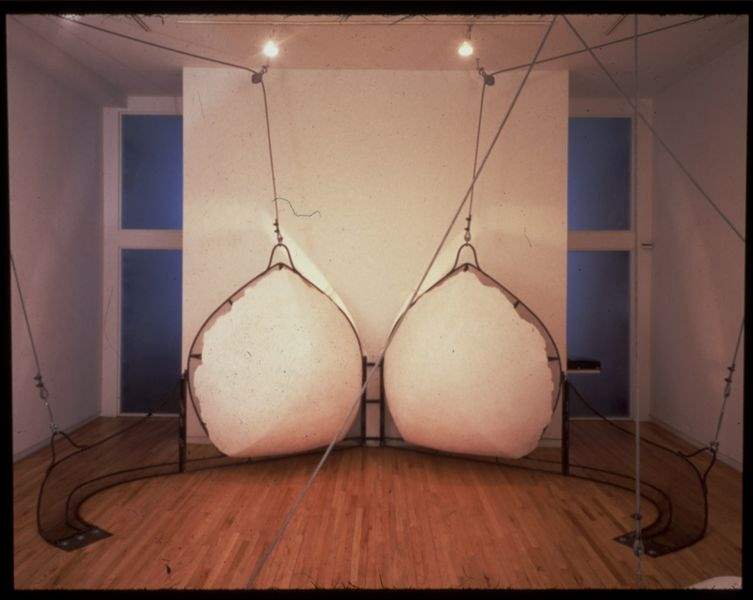
New York's `Open Ends' exhibit is a flea market of later-date ideas
11/12/2000
"Ajustable wall Bra" (1990-91), by Vito Acconci, is made of steel chain and plaster.
NEW YORK - Imagine a mishmash of modern art packed to the walls in a stylish warehouse: propaganda posters, steel cubes, shiny white canvases, photos, movies, and a giant concrete-and-chain-link brassiere.
The vision is real through January at the Museum of Modern Art in New York City. The show is called “Open Ends,” and as art exhibits go, this one's a flea market of later-date art and ideas.
Museum curators said they found the the millennium year a good time to show off MOMA's collection of large-scale contemporary artwork, while exposing lesser-known masterpieces usually kept in storage. No one's trying to make sweeping statements with these “Eleven Thematic Exhibitions of Contemporary Art from 1960 to Now.” There's an individual sermon or two, and the occasional shrill or false note, but remember, this IS modern art, after all. If you want serene madonnas and seaside scenes, head over to the Metropolitan Museum of Art.
So throw out your expectations and take your time - here are some of the best and brightest of the last 40 years, many of them brand new, and the rest still as fresh, puzzling, witty, moving, or nonsensical as the day they were first displayed.

Blasted Pencil (That Still Writes), 1984, by Claes Oldenburg.
Architecture Hot and Cold is a lineup of architectural plans, photos, and models of structures. Architects like Rem Koolhaas are featured alongside architecture-influenced artists like Andy Warhol and Joel Shapiro. But keep moving - things get better.
Innocence and Experience is a group of images, films, and sculptures that deal with the positive power of childhood and purity, and the darkness of corruption and adolescence. It's an intriguing subject that would suit a much larger display, and this group of grinning dolls, stainless-steel Easter bunnies, and delicate wax Mary-Jane shoes sprouting brutish hairs could take up an afternoon's viewing. Here are works by stars like Diane Arbus, Robert Gober, Jeff Koons, Louis Malle, and Satyajit Ray.
Matter is thought-provoking in a fundamental way - it looks at the wildly different ways different artists make use of the same raw materials. The best example is felt, that thick wool material so familiar to all kindergarten graduates. Gaetano Pesce made a Cinderella-fantasy chair from it; Joseph Beuys made Fat Felt Sculpture, a huge business suit; and Robert Morris's Untitled stretches it in strips off the wall like a 3-D highway-to-horizon picture.
One Thing After Another is familiar to anyone who saw the “Multiples of the Sixties” Pop Art show at Toledo Museum of Art last spring. It explores the lure of mul-
tiple images and prints made popular by Roy Lichtenstein and Warhol, and brings it into the experimental printmaking of the '80s and '90s, foucusing on Dennis Adams's
Patricia Hearst, A thru Z, a sort of tabloid mugshot evolution from ingenue to revolutionary to bride. Pop and After is an extension of the theme, with all-star, industrial-size examples by Claes Oldenburg and Damien Hirst.
Actual Size is a funhouse display of artists at play with scale, recreating with artist's materials everyday items like kitchen sinks, kitty-litter bags, insects, and egg yolks.

"Ajustable wall Bra" (1990-91), by Vito Acconci, is made of steel chain and plaster.
Sets and Situations is a showcase for photographer Cindy Sherman, who pioneered the set-piece self-portrait by posing herself as a wide variety of Hollywood-flavored personas. A complete cycle of Sherman's Untitled Film Stills is a backbone of the show.
Minimalism and After, meant to echo the “Pop and After” idea, uses works by Tony Smith, Richard Serra, Janine Antoni, and Jackie Winsor to explain the 1960s' fascination with cubes and floor sculptures. Felix Gonzalez-Torres's river of silver-wrapped candies redeems a roomful of dreary boxes. And here is Cy Twombly's breathtaking housepaint-and-crayon Untitled 1970, one of the finest pieces in the museum.
White Spectrum is a demanding show of monochromes, fascinating, subtle, and oh-so-modern, worth another afternoon's browsing.
The Path of Resistance appeals to media-savvy art lovers. It's all about politically and socially charged propaganda, agitation, and provocation, dressed up as artfully designed posters, films, flyers, and comic books. It links well with Counter-Monuments and Memory, a show of works meant to memorialize the lost, and question the entire idea of memorials.
And that's only the loosely organized artwork. Scattered among it all are large-scale installations that defy classification: A nine-artist montage of videos and films, Cai Guo-Qiang's fascinating, arrow-bristling sculpture Borrowing Your Enemy's Arrows, and Medusa's Head, Chris Burden's room-size asteroid of broken concrete, wrapped about with model trains and tracks.
Even with all this going on upstairs, don't forget the first-floor galleries, full of the museum's tip-top examples of Matisse, Rousseau, Brancusi, and Dali. “Open Ends” may be a mishmash, but it's worth a trip to New York to see so many wonders tumbled together in one place.
“Open Ends” was installed in phases; it will remain on show in its entirety through Jan. 2, when “Architecture,” “Innocence,” “Matter,” “One Thing,” and “Pop and After” will close. The remaining shows will close Jan. 30. For detailed information, contact MOMA at 212-708-9750.